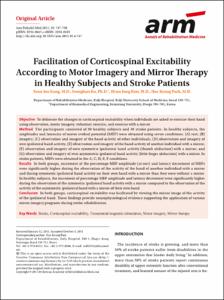KUMEL Repository
1. Journal Papers (연구논문)
1. School of Medicine (의과대학)
Dept. of Biomedical Engineering (의용공학과)
Facilitation of Corticospinal Excitability According to Motor Imagery and Mirror Therapy in Healthy Subjects and Stroke Patients
- Keimyung Author(s)
- Ku, Jeong Hun
- Department
- Dept. of Biomedical Engineering (의용공학과)
- Journal Title
- Annals of Rehabilitation Medicine
- Issued Date
- 2011
- Volume
- 35
- Issue
- 6
- Abstract
- Objective To delineate the changes in corticospinal excitability when individuals are asked to exercise their hand
using observation, motor imagery, voluntary exercise, and exercise with a mirror.
Method The participants consisted of 30 healthy subjects and 30 stroke patients. In healthy subjects, the
amplitudes and latencies of motor evoked potential (MEP) were obtained using seven conditions: (A) rest; (B)
imagery; (C) observation and imagery of the hand activity of other individuals; (D) observation and imagery of
own ipsilateral hand activity; (E) observation and imagery of the hand activity of another individual with a mirror;
(F) observation and imagery of own symmetric ipsilateral hand activity (thumb abduction) with a mirror; and
(G) observation and imagery of own asymmetric ipsilateral hand activity (little fi nger abduction) with a mirror. In
stroke patients, MEPs were obtained in the A, C, D, E, F conditions.
Results In both groups, increment of the percentage MEP amplitude (at rest) and latency decrement of MEPs
were significantly higher during the observation of the activity of the hand of another individual with a mirror
and during symmetric ipsilateral hand activity on their own hand with a mirror than they were without a mirror.
In healthy subjects, the increment of percentage MEP amplitude and latency decrement were signifi cantly higher
during the observation of the symmetric ipsilateral hand activity with a mirror compared to the observation of the
activity of the asymmetric ipsilateral hand with a mirror of their own hand.
Conclusion In both groups, corticospinal excitability was facilitated by viewing the mirror image of the activity
of the ipsilateral hand. Th ese fi ndings provide neurophysiological evidence supporting the application of various
mirror imagery programs during stroke rehabilitation.
Key Words Stroke, Corticospinal excitability, Transcranial magnetic stimulation, Motor imagery, Mirror therapy
- Keimyung Author(s)(Kor)
- 구정훈
- Publisher
- School of Medicine
- Citation
- Youn Joo Kang et al. (2011). Facilitation of Corticospinal Excitability According to Motor Imagery and Mirror Therapy in Healthy Subjects and Stroke Patients. Annals of Rehabilitation Medicine, 35(6), 747–758. doi: 10.5535/arm.2011.35.6.747
- Type
- Article
- ISSN
- 2234-0645
- Appears in Collections:
- 1. School of Medicine (의과대학) > Dept. of Biomedical Engineering (의용공학과)
- 파일 목록
-
-
Download
 oak-aaa-00319.pdf
기타 데이터 / 1.17 MB / Adobe PDF
oak-aaa-00319.pdf
기타 데이터 / 1.17 MB / Adobe PDF
-
Items in Repository are protected by copyright, with all rights reserved, unless otherwise indicated.